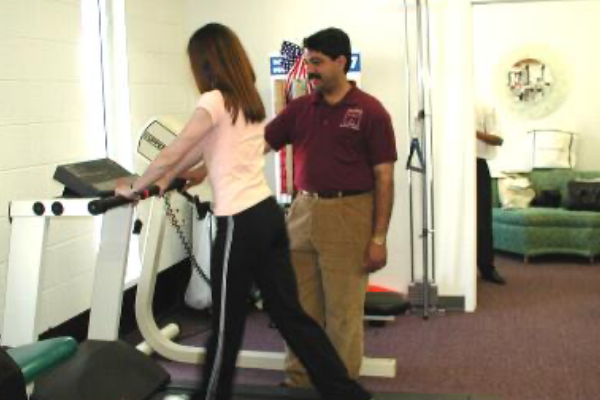How to Properly Recover from an Ankle or Knee Sprain
Have you recently suffered from an ankle or knee sprain? One day you are active and able to walk/run with ease and the next, you’re experiencing incredible pain coming from your knee or ankle.
Here are some tips that can help you in recovering, and help prevent future injury…
What is a Sprain?
Every joint in the body has bands of tissue that holds them together. These bands are called ligaments. When the ligaments turn outside of their normal range of motion, they overstretch and experience micro-tearing. The body responds by creating inflammation and going through a healing process to stitch the tissue back together.
In ankles, the ligaments on the outside of the joint are the most likely to be injured. In knees, any of the ligaments can be injured because the knee rotates in several different ways, but the inner knee tends to be more common.
IMPORTANT: If you feel your injury is significant, you could have a Grade 2 or Grade 3 sprain. You should see a medical professional as soon as possible, such as a doctor of physical therapy. They can perform tests to determine the extent of the sprain and direct you on the right course of treatment.
In most cases physical therapists will be able to help you on the best path to recovery, recommend a brace, or refer you to an orthopedic physician if imaging testing or casting is necessary. This helps you avoid costly imaging tests or medical procedures, if not needed.
Every ankle sprain or knee sprain has three phases of recovery. While healing takes between two weeks and two months, there is no magic formula for making the process go faster. However, systematically moving through these phases allows the joint to heal properly and reduces the likelihood of re-injuring the joint.
Follow the 3 Phases of Recovery
Phase 1: R.I.C.E.
The first phase of joint recovery can be described with the acronym R.I.C.E. – Rest, Ice, Compression, Elevation. This phase can last from a few days, up to a week in order to give the ankle or knee a chance to begin healing.
- Rest your knee or ankle by minimizing the walking on it, using crutches if necessary.
- Ice the knee or ankle for 15 minutes at a time to keep inflammation at a minimum. However, you should never put ice directly on the skin. Instead, wrap an ice pack in a thin cloth or pillowcase to prevent frostbite. Check your skin frequently.
- Compression can be achieved by using a wrap around the injured joint. Not only does compression add support to a weakened joint, it reduces swelling as well.
- Elevating the knee or ankle above the waist or the heart also reduces swelling in the joint. Prop it up on pillows, the arm of the couch, or another supportive, soft surface multiple times a day, when sitting or resting.
Phase 2: Gently Restore Flexibility & Range of Motion
24 hours after the injury, you should begin very gentle movement of your ankle or knee. It will feel tight when you move, but don’t push through any pain. For ankle sprains, gentle point and flex are the best motions. For Knee sprains, gentle extending of the knee is best. Again, work within the pain free range your joint allows you too. Over days, this will improve and allow you to move further.
At this point, enlisting the help of a physical therapist can help restore strength and balance to your knee or ankle while decreasing the likelihood of re-injuring it in the process.
A physical therapist can perform cross friction massage that ensures the fibers within the ligaments align properly and not improperly adhere to tissue or bone. PT at this stage also involves several hands-on therapies that continue to control swelling and manage pain without the use of pain medications.
Phase 3: Restore Strength & Balance to Prevent Future Re-Injury
Once the joint has begun to heal, it feels better and motion will have been restored. However, if strength and balance are not properly restored, your joint is weaker and more likely to be re-injured, even months later. The next sprain will most likely be worse as the ligaments are never back to 100% strength.
Simple exercises such as balancing on one foot for 20 seconds at a time, can help with balance and strength. Do toe raises 10-15 times for 2-3 sets to increase strength in the ankles and knees. Again, this should be done pain-free.
Why Should I See a Physical Therapist?
A few simple visits to a physical therapist can teach you the proper strengthening exercises that will help restore your range of motion, strength, balance, and proprioception (the ability to sense where the joint is in space).
Many people assume that once they are no longer in pain, they can go back to normal activities. In reality, physical therapy is the only way a person can achieve a full recovery from a knee or ankle sprain.
A carefully constructed, supervised exercise program not only on helps to strengthen the ligaments holding the joint together, it also strengthens the muscles around the joint, preventing future injuries.
When done correctly, with physical therapy, recovering from a knee or ankle sprain can leave you as good as new in a few short weeks.
Always consult your physical therapist or physician before starting exercises you are unsure of doing.
Sources
http://www.aofas.org/footcaremd/how-to/foot-injury/Pages/How%20to%20Care%20for%20a%20Sprained%20Ankle.aspx






